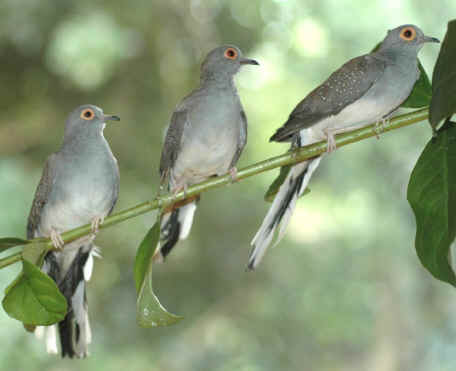|
Welcome to the Diamond Dove Home Page. MAIN MENUDiamond DovesSite Map Diamond doves Acquiring Diamond Doves Caring for Diamonds Living With Diamonds Raising Diamonds Growth of a Diamond Baby One Year's Reproduction Data Tribute to China Other Dove SpeciesOther Geopelia SpeciesRingneck Doves Eurasian Collared Doves Cape Doves Mourning Doves Mourning Dove Baby Growth Rock doves North American Doves Dove Genera of the World All Doves Caring for Injured or Sick DovesTaming Doves Other
Books of Interest LinksInformational SitesAmerican Dove AssociationCommercial SitesJeff Dowining - Diamond DovesGarrie Landry - Diamond Doves Wade Oliver - The Dove Page Doveland Press - Diamond Doves
|
ACQUIRING DIAMOND DOVES
Isaac and Abe
This photograph was used with the permission of Charlotte C. Van Hoozier, MD
Page Contents
Should I Keep Doves as Pets in my Home
Should I Keep Doves as Pets in my HomeOne of the first questions readers to ask yourself before bringing any birds home, is this something you really want to do in the long term (10 to 15 years?) and if you do feel you want this then do you have a situation that is suitable for the birds? Do you have time to take care of the birds needs every day for as long as they stay with you. Do you have a warm, sunny, draft free, stress free environment where the birds can live. Do you have time to provide fresh water and seed on a daily basis and clean cages, water containers, and seed cups on a weekly basis? Will you be able to take sick birds to an avian veterinarian when necessary? And if you keep a pair, are you willing to take the time to find suitable homes for their offspring if you do not want to keep them yourself? If you go on vacations, can you get a trustworthy person to take care of your birds while you are gone? And if you are old like I am, do you have someone who will take care of your birds after you are gone? If your answer is yes to these questions then you may wish to read the remainder of this page and the next two pages to see what is involved in obtaining and caring for pet doves. Where To Obtain BirdsMany readers write and ask where can they find diamond doves. Often times these birds are not carried in local pet stores because of greater demand for parrots and related species. If you can visit stores in larger cities you may have better luck than those in smaller towns. However pet stores may not be a good location for obtaining doves as pet store owners often have little knowledge of doves, are unable to tell their sex, and cannot guarantee that you are obtaining an unrelated pair when you are buying a male and female. The second place to look is local breeders. They may or may not be listed in telephone book yellow pages. Prior to August 2008 I used to provide a list American Dove Association (ADA) members for an entire state of interest. I no longer am able to provide that service. If you wish to obtain ADA member addresses you can join the association. Use the link in the left hand menu. Reputable breeders are usually a good source of birds because they usually have considerable knowledge about their birds and usually can sex them once they are beyond four or five months of age. Good breeders will always band their birds and because of this you can be assured of the birds’ age. Also local breeders usually sell the birds at a cheaper price than either pet stores or large commercial breeders that mail their birds all over the country. If you can not find a local breeder then you may be able to find breeders from distant locations at local bird shows. You can locate time, dates, and locations of bird shows by doing a search on the internet. Try this link: www.birdsnways.com/birds/shows.htm. However, before traveling any distance to such a show, you should call ahead and try to determine if anyone will be selling doves at the show. Bird shows are also an excellent source of cages, other bird related products, and books at reasonable prices. As a last resort you may want to order birds from one of the commercial breeders by mail order. Usually this must be done in the spring and fall months to avoid temperature extremes of the winter and summer months. However this varies by the location of the breeder and purchaser. Birds are usually sent by overnight mail. The main disadvantage of receiving birds by mail are that you can not examine the birds prior to purchase and the amount of stress the birds undergo by being placed in a box for the period of the shipment. There are good commercial shipping boxes available that include a seed dish and a sponge dish for water. These containers also include translucent portholes for light. The boxes usually have a wide bottom and narrow top which makes it almost impossible to place the box upside down. It should be noted that express mail does not always result in overnight delivery. I have had birds shipped to me that took three days to arrive. However all the birds were in good condition and there was still some seed left in their seed dish. Deciding on How Many Birds To AcquireThere are many opinions about the number of birds to acquire and what the sex of those birds should be. I believe the biggest issue is how much time you will be able to spend with a bird. If you work at home or are retired, you may want to consider purchasing only one bird and developing an affectionate, loving relation with that bird. Most doves can become quite affectionate if they are well treated by their owner and sufficient time is given to developing the relationship. Often a single dove will become mildly aggressive in the development of such a relationship. In such a situation the bird will want to be allowed out of their cage when the owner is at home and will try to stay close whenever you are in one place for any time. I have such a bird that spends considerable time on my desk when I working on my computer. Single birds are often good study companions for students. If you are away at work all day or if you travel frequently, then it would be better to have two or more birds. Diamond doves are gregarious in nature and often live in large flocks where there is considerable interaction. At this writing I have a flock of 14 birds at the present and these birds “talk” to each other almost all day, from the time it is light in the morning until it starts to get dark in the evening.. If you decide to get two birds then the nest question is whether to get a pair (a male and a female) or get two birds of the same sex. I recommend getting a male and female and letting the birds, nest, lay eggs, and raise babies. In my opinion such birds will lead a much happier life than two of the same sex which my spend most of their time sleeping on their perch or “scootching” on the bottom of the cage and rarely uttering a single coo. If you do get a male and a female, eventually you will need a nest, nesting material, and later a second cage for the babies after they leave their parents. Most diamonds become sexually mature in three to four month. At this time they can usually be sexed both by physical appearances and by their interaction with others. Then they can be sold or given away. And finally, if you wish to produce unrelated pairs of doves for sale then you will need two unrelated pairs or four birds and two cages plus a baby cage. If you do decide on two birds of the same sex I recommend getting two males as in this way you can avoid the nesting, egg laying, and calcium problems that occur when you have females Two male birds may fight on occasion (have separate cages if needed) and they can develop a very loud advertising coo that can easily become very annoying. But eventually they usually settle down in time.Two females usually will get along better than two males. If you do get two females, then you should provide a nest and nesting material. Eventually the birds will probably bond on each other and both will lay infertile eggs in the nest and incubate them for the normal 14 days plus a few more. Once the birds abandon the nest, the eggs can be removed and the nest can be cleaned or replaced. If you keep a pair of
females that bond on each other
and lay eggs, they should be encouraged to incubate their eggs for the
full 14 day incubation period. This will keep the doves from
laying eggs more than once every three weeks or so. Spacing out
laying frequency will help in preventing low calcium levels which can
result in thin shelled eggs, soft shelled eggs, dwarf eggs and egg
binding. If any of these symptoms occur it should be a
good idea to have liquid calcium available like Vetafarm's Calcivet I feel it is best to let females incubate the eggs
rather than removing them immediately, as this method keeps the birds from
laying eggs more than once every three weeks or so.
Some people will buy various finch species to live with their
diamonds as it is generally reported that these species are compatible in larger cages or aviaries.
I have no personal experience in this matter, but I have heard that finches will
gently harass the diamonds and will even plot to remove their tail feather to use as their nesting
material especially when they are kept in small enclosures. However, many
people have reported seeing badly damaged diamond doves in pet stores that have
been kept with finches, canaries, or other small birds. One woman wrote
that she found a single diamond that was bleeding and missing most of his
feathers because he was kept in a cage with finches. This woman persuaded
the pet store owner to give her the bird for free and she took it home and cared
for it and after two months she finally got him back to normal.
Unless
you have a very large enclosure I recommend you do not keep finches with your
diamond doves.
Often if you intend to buy a male and female you will be able to buy an established pair.
Diamonds like to select their own mates and when two birds are put together without the benefit of self
selection they may turn out to be incompatible or it may take several months for the two to decide that
if they want a family they will have to make do with each other. I have paired some birds that absolutely
refused to consider mating and in some case the two birds would constantly fight. But if you must
buy unpaired birds then the sexing guidelines below should be of some help.
Diamond doves do have slightly different physical appearances that may be useful in
determining the sex of the birds you are purchasing in case the seller is not knowledgeable about the sex
of his birds. I can only address the sex of the wild type doves and not the color mutations as I
have never raised the later.
Eye rings - Males at least four to six months old may have an orange eye ring that is
2 to 3 mm in thickness. Female almost always have an eye ring of about 1 mm
to 2 mm in thickness. However there are exceptions.
EYE RINGS OF MALE AND FEMALE DIAMOND DOVES |
||||
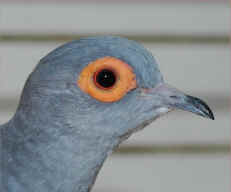 |
 |
||||
| Peep Age 8 | India Age 6 | ||||
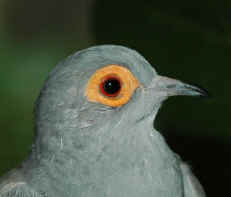 |
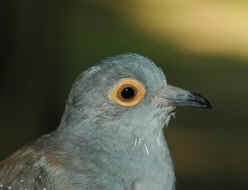 |
||||
| Sikkim Age 5 | Taiwan Age 8 | ||||
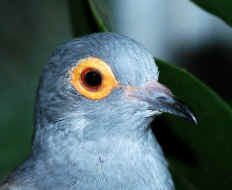 |
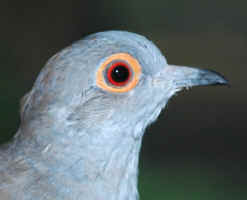 |
||||
| Henry Age 8 |
Kashmir Age 3.5 |
||||
| Eye Rings of Male Diamond Doves | Eye Rings of Female Diamond Doves | ||||
|
Feather coloration - Males at least six months old usually have a blue gray color of their wing and back feathers. Younger males and females usually have a brownish gray color. In the photograph below, the male is on the left and he has the characteristic blue gray color on his back. The female is on the right and you can see she has a slight brownish cast to her feathers. We have some older females which have a pronounced brownish cast. In this photo the female appears bigger than the male and her eye ring appears to be almost the same size as the male. In reality they both have the same weight. Nepal (Male - 8 years) and Nanda Devi (Female - 3.5 years) Physical Size - If you see male and female birds together, males over six months in age will probably be larger than the female (the two doves in the above photo are an exception). Males and females of less than six month in age will be about the same size. This trait is only useful if you know you have a male and female. If you have two birds of the same sex, one can easily be larger than the other, but that will not indicate that the larger one is a male and the smaller is a female Weight - Over the past year we have taken occasional weight measurements of all our diamonds. The average weight for weight measure for adult males was 31.6 grams and for adult females was 29.6 grams. It should be noted that there have been times when some males weighed less than the average female and some females weighed more than the average male. Voice - Males are usually much more vocal then females are. Females are very quiet and when they do coo have a higher pitched voice. However, a birds of both sexes in a pet store environment will probably be very quiet. And even after you first take a bird home they may be quiet for weeks. Bow coos - Males will do bow coos, the mating display where the bird repeatedly touches his beak to the ground, fans his tail, and coos as early six weeks of age. Females will almost never will do a bow-coo unless they have been kept in the company of females without any males for a long period of time. I have also seen a female dove in this situation mount another female that she was living with as if they were mating. Eggs - Of course only females lay eggs. Females diamonds will lay eggs as early as 12 weeks of age.
Three Male Diamond Doves
Three Female Diamond Doves It is definitely easier to tell males from females when they are side by side. The three males appear to have the thicker eye ring until you look at the female Nanda Devi which has an eye ring that is much larger than Taiwan's or Kashmir's. The males appear to have a huskier body than the females do and their heads are larger and blockier. As mentioned above, the females have a slightly brownish cast to their feathers while the males have more of a blue-gray cast but this is really hard in these photos. There are several things to watch for when you are purchasing a new bird: Appearance: If you can, observe the bird of interest from a distance before it is frightened by your approach. Do it appear healthy, happy, and well fed? Is the bird's profile smooth and without any unnatural lumps or bumps? When you approach the bird, does it fly from perch to perch or get off the cage floor and walk around? Does it appear alert and even excited? Feet: Always take time to check the feet for injury. Are the feet clean without any kind of encrustations? Sometimes an infestation of mites will result in white deposits. Are the bird's claws in good condition? Missing claws will not grow back Claws that have been broken off may be the result of exposing the bird to below freezing temperatures for some time and allowing the bird to sit on round perches instead of flat perches. Sitting on flat perches allows the birds feathers to cover the feet and protect them form the cold while round perches prevent this. Birds that have frozen feet often get infections that can kill the bird of not treated immediately. When walking, does the bird have an even gait without any signs of limping? Wings: When standing with the wings folded, do the tips of the longest flight feathers almost meet over the bird's back. Are the tips of the flight feathers from each wing at the same height? Beak: Are the upper and lower parts of the beak in good alignment? Are the upper and lower parts of the beak of equal length? Is the beak surface smooth and without irregularities? Is the beak free from any white deposits that may indicate a mite infection? Are the nostrils clear and open or are they partially or completely closed? Eyes: The birds eyes should be bright and clear, and should have no signs of any discharge. The bird should not be constantly blinking or closing one eye nor should be be rubbing the eye against his shoulder because of an irritation, Feathers: Are their feathers smooth and tight or does the bird fluffed up and appear cold and sick? Do the feathers show signs of severe pecking? This could be caused by the bird pecking at irritations caused by various parasites. You can open the wing and hold it up to the light to check for parasites. You should open the feathers in a number of locations and look at the skin for signs of parasite irritation. Are the wing feather tips intact or are the badly broken? Wing feather damage could simply be caused by the bird being frightened by people or other animals. Vent area: Check the feathers around the vent. They should be clean and dry. If the feathers are green or covered with white residue the bird has an intestinal problem and should probably not be purchased. Stools: Check the stools on the bottom of the cage. The stools from a healthy birds will be dry and solid. Green stools are an indication of a sick bird as are wet, runny stools. However, healthy birds will have wet stools when they are under stress. Breast Bone: Birds that are sick will have a reduced ability to feed and will thus loose weight as the bird’s high metabolism will convert the chest muscle to energy. This reduction of muscle mass will make the chest or keel bone more prominent. Thus birds with a prominent keel bone should probably not be purchased. Bands: Birds should be banded with a band that show their year of hatching. Sellers should also be able to provide the hatch date. Birds should be at least four months old in order to be able to sex the the bird properly. If the birds turns out to be the wrong sex, the seller should agree to refund your money upon return of the bird or he should immediately provide a bird of the correct sex. Bringing Diamonds HomeBefore you leave your home to get your new bird, be sure to have its cage all set up with food, grit, a cuttlebone, and water as described on the next page so you will not have to fuss with the cage once the new bird is in it. Consider providing an incandescent light in or near the cage if it is located in a dark area or if the room is cool and the heat from the lamp would be appreciated by the birds. Do consider a lamp during the first few days even if it is taken away later. Birds will probably be brought home in a small travel cage. A ventilated shoebox also works well. If the travel distance is considerable then seed, millet spray, and water soaked bread should be provided. Do not include water in the cage or it will probably spill. But if the trip is several hours in duration you may want to offer the bird water in a manner that will not allow its escape for the carrier or box. Dr. Vriends recommends bringing birds home as early in the day as possible (4). This allows the birds most of the day to acclimatize to their new surroundings before nightfall. Be sure to provide a night light on the very first night. In the winter take care to avoid severe temperature changes. Have the car warm before bringing the birds inside. Covering the cage while it is carried from the place of purchase to the car, and from the car to the house will preserve some of the heat. If birds to become cold then they should be warmed gradually to avoid discomfort and possible injury. Initial Quarantine and StressTransferring new birds from a travel box to their new cage is a critical operation. Extreme care should be taken that the birds do not escape into the room as they may be extremely frightened and thus will fly at high speeds into walls, uncovered mirrors, or widows which can result in serious injury or death. Pulling shades and having the room in semi darkness may facilitate the transfer. You can also block the carrier or box opening with a towel arranged so the birds can not fly out as you reach inside to move them into the cage. Do realize if you make a mistake here your new birds may die. When you first bring a bird into your home the birds will be under a considerable amount of stress because of moving to a new environment. Most birds do not deal well with such changes. To minimize stress new birds should be placed as far away from the other birds (and pets) as possible. The cage should be located in a low traffic area that is quiet, warm, and draft free. Birds often hyperventilate because of stress when they are brought into a new home. But once they are taken in and moved into a warm, quiet area, they will soon began to calm down Once they start to preen their feathers and eat, the worst of the effects probably have passed.. During the first week or two, the new bird should not be allowed out of its cage. At first the cage should only be approached by the same person (never wearing bright colored clothes) only to provide additional seed and fresh water. And be sure the cage area is provided with some kind of night light to prevent the bird from being frightened by the slightest noise at night and the thrashing about breaking many of its feathers. This period of time should also be considered a period of quarantine that you will use to examine the bird for illness and external and internal parasites that might be spread to any other birds you might have. If you carefully observe the new bird for a period of one to two weeks and the bird appears normal in every respect, then it is probably safe to move the bird to a location adjacent to any other birds you may have. If the bird is not normal, a longer quarantine would be recommended and possibly an examination by a veterinarian would be in order. References
(1) Brown, Danny, "Quarantine and Care of Newly Acquired Stock", A Guide to Pigeons, Doves & Quail, Their Management, Care & Breeding, South Tweeds Heads, Australia: Australian Birdkeeper 1995, pp. 43-44
©1997 to 2013 - Helen White P. O. Box 367, Tallahassee, FL 32302-0367 Last revised on: September 29, 2013
|
|||||


